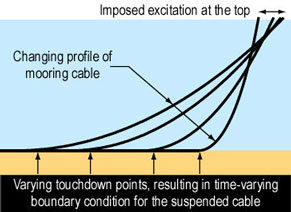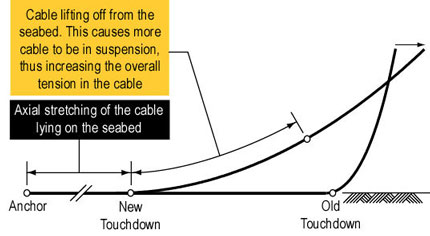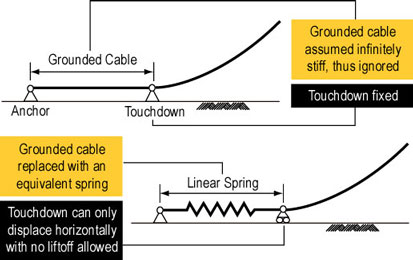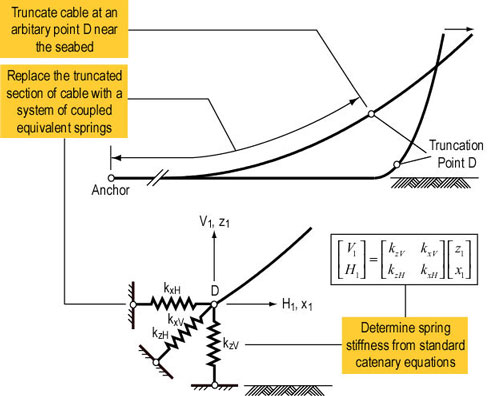
Modelling of Seabed Interaction in Frequency Domain Analysis of Mooring Cables
Offshore structures rely heavily on the performance of mooring cables to stay in position. Accurate modelling of mooring cables however requires lengthy non-linear computations. For example, seabed interaction results in a time-varying boundary condition which is difficult to model in full. A new method of modelling seabed interaction using a linearised computational scheme is proposed, which will improve the overall accuracy of mooring cable analysis.
This research is a collaboration between BP, Noble Denton Europe and Cambridge University, with funding from Department of Trade and Industry and BP.
INTRODUCTION Mooring cables play an important role in anchoring offshore structures to the seabed. Their slender behaviour in water are often difficult to understand and model. Their interaction with the seabed further complicates the problem. When excited under wave loading, there cables interact dynamically with the seabed, creating a boundary condition that varies in time and space. To model this interaction in full, one would have to carry out a lengthy time domain analysis. A more efficient approach would be to model in the frequency domain, which is however a linear method of analysis. |
 |
The problem can be better understood by dividing the interaction into two separate yet dependent mechanisms occurring simultaneously whenever a cable is excited--(i) constant lifting off and touching down of the cable, and (ii) the axial stretching of the cable lying on the seabed. |
 |
|
Traditionally, two methods of modelling seabed interaction exist in the frequency domain--(i) pinning the touchdown; or (ii) replacing the grounded cable with an equivalent spring. None of the existing methods takes into account the effect of liftoff and touchdown of the cable during excitation. It is observed that neglecting this effect, the frequency domain analysis would yield inaccurate cable tensions under large excitations. This research aims to develop a new method of modelling seabed interaction in the frequency domain, which will account for both the stretching of grounded cable and the liftoff and touchdown action of the cable. |
 |
|
METHODOLOGY The approach adopted is to model the section of cable near the seabed with a system of linear coupled springs, shown here in 3 principle steps. It is assumed that dynamic effects near the seabed are negligible and thus can be ignored. Static catenary equations are then used to determine the required spring stiffnesses through a linearisation process routinely adopted in the linearisation of fluid drag. |
 |
RESULTS
The proposed new method, together with the two existing methods mentioned earlier, are tested and compared against a full time domain situation. The comparison is carried out for both small and large excitations.
Comparing over a range of excitation periods with a fixed excitation amplitude of 1m.
|
|
|
Comparing over a range of excitation amplitudes with a fixed period of 10 seconds.
|
|
|
CONCLUSIONS
The proposed new method of modelling seabed interaction has shown to improve the overall accuracy of frequency domain analysis. Under large excitations, neglecting the effect of liftoff yields inaccurate cable tensions is also verified. Besides mooring cables, this new approach can also be applied to the analysis of catenary rises or any problems involving cable-structure interaction.
For detailed explanation of the proposed method, see OMAE 2003 paper. The above information is reproduced from a poster presented at the Institution of Structural Engineers' Young Researchers' Conference.
Last updated on the 20th of Jan, 2002
P. Ong - ppao2@cam.ac.uk